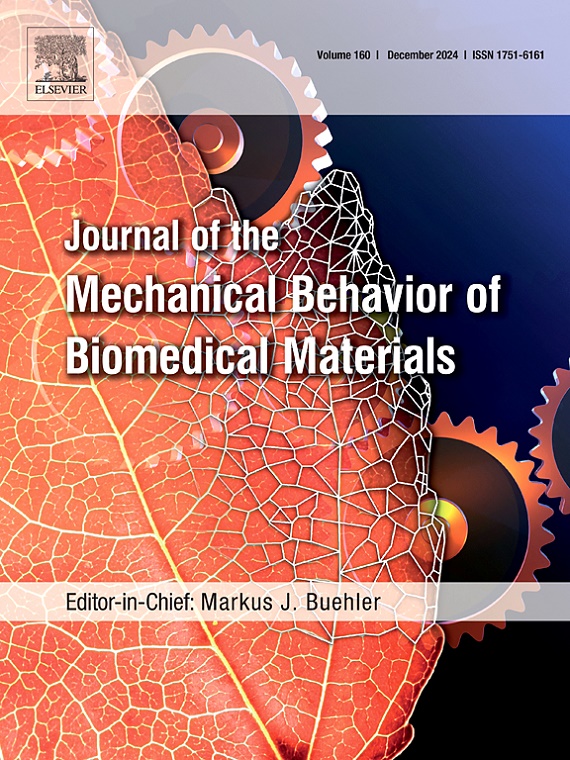Impact of physiological and non-physiological loading scenarios and crown material on periimplant bone stress distribution: A 3D finite element study
IF 3.3
2区 医学
Q2 ENGINEERING, BIOMEDICAL
Journal of the Mechanical Behavior of Biomedical Materials
Pub Date : 2025-01-16
DOI:10.1016/j.jmbbm.2025.106894
引用次数: 0
Abstract
This study numerically investigates the impact of different loading modes on the biomechanical response of an osseointegrated dental implant. While finite element modeling is commonly employed to investigate the mechanical behavior of dental implants, several models lack physiological accuracy in their loading conditions, omitting occlusal contact points that influence stress distribution in periimplant bone. Using 3D finite element modeling and analysis, stress distributions at the bone-implant interface are evaluated under both physiological loading, incorporating natural occlusal contact points, and non-physiological loading conditions, with a focus on load transmission mechanisms and the potential risk of bone overloading. Two crown materials, zirconia and lithium disilicate, are analyzed under load values of 150 N and 300 N. The physiological loading mode leads to significantly higher Von Mises stress concentrations in both cortical and trabecular periimplant regions compared to non-physiological loading. This results in different load transfer mechanisms underlining the importance of accurately modeling load application points. Crown material seems to have a minimal impact, whereas increasing the load intensity markedly increases stress levels. Notably, physiological loading reveals stress distribution at the implant apex, unlike non-physiological models. Additionally, peak values of tensile and compressive stresses at the periimplant interfaces increase under physiological conditions, with cortical bone stress rising by up to 210%. This highlights that relying on non-physiological loading modes may inadequately capture the risk of implant failure. Overall, these results emphasize the need to consider physiological loading scenarios, particularly for assessing failure risk to better guide implant design modifications, enhancing clinical outcomes and implant longevity.

生理性和非生理性负荷情况及冠材对种植周骨应力分布的影响:一项三维有限元研究。
本研究通过数值方法研究了不同载荷模式对骨结合种植体生物力学响应的影响。虽然有限元模型通常用于研究牙种植体的力学行为,但一些模型在其加载条件下缺乏生理准确性,忽略了影响种植体周围骨应力分布的咬合接触点。利用三维有限元建模和分析,评估了含自然咬合接触点的生理载荷和非生理载荷条件下骨-种植体界面的应力分布,重点研究了载荷传递机制和骨超载的潜在风险。在150 N和300 N的载荷下,对氧化锆和二硅酸锂两种冠材料进行了分析。与非生理载荷相比,生理载荷模式导致皮层和小梁周围区域的Von Mises应力浓度显著增加。这导致了不同的负载传递机制,强调了准确建模负载应用点的重要性。冠材料似乎有一个最小的影响,而增加负荷强度显著增加应力水平。值得注意的是,与非生理模型不同,生理负荷揭示了种植体尖端的应力分布。此外,在生理条件下,种植体周围界面的拉伸和压缩应力峰值增加,皮质骨应力上升高达210%。这突出表明,依赖于非生理加载模式可能无法充分捕捉到植入物失败的风险。总的来说,这些结果强调需要考虑生理负荷情况,特别是评估失败风险,以更好地指导种植体设计修改,提高临床效果和种植体寿命。
本文章由计算机程序翻译,如有差异,请以英文原文为准。
求助全文
约1分钟内获得全文
求助全文
来源期刊

Journal of the Mechanical Behavior of Biomedical Materials
工程技术-材料科学:生物材料
CiteScore
7.20
自引率
7.70%
发文量
505
审稿时长
46 days
期刊介绍:
The Journal of the Mechanical Behavior of Biomedical Materials is concerned with the mechanical deformation, damage and failure under applied forces, of biological material (at the tissue, cellular and molecular levels) and of biomaterials, i.e. those materials which are designed to mimic or replace biological materials.
The primary focus of the journal is the synthesis of materials science, biology, and medical and dental science. Reports of fundamental scientific investigations are welcome, as are articles concerned with the practical application of materials in medical devices. Both experimental and theoretical work is of interest; theoretical papers will normally include comparison of predictions with experimental data, though we recognize that this may not always be appropriate. The journal also publishes technical notes concerned with emerging experimental or theoretical techniques, letters to the editor and, by invitation, review articles and papers describing existing techniques for the benefit of an interdisciplinary readership.
 求助内容:
求助内容: 应助结果提醒方式:
应助结果提醒方式:


